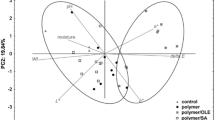Abstract
Changes in quality attributes and antioxidants content of tomato slices coated with gum Arabic at different concentrations then sun- or air-dried were investigated. Drying increased the dry matter content and the rehydration ratio with increase in gum Arabic concentrations. The water activity was fluctuated. Slices coated with 10% gum Arabic and air-dried had a maximum dry matter content (84.87%), a minimum water activity value (0.27) and a higher rehydration ratio (4.69), compared to uncoated slices. Drying of slices before and after coating had no significant (p≤0.05) effect on the pH. Coating of the slices followed by drying had no effect on the total soluble solids content. Blanched slices coated with 10% gum Arabic and sun-dried had a lower browning index value (0.029). Dried uncoated slices were darker than coated slices. Surface coating alleviates the effect of heat on the ascorbic acid, total phenolics, and flavonoid contents.
Similar content being viewed by others
References
Ahmed L, Martin-Diana AB, Rico D, Barry-Ryan C. Quality and nutritional status of fresh-cut tomato as affected by spraying of delactosed whey permeate compared to industrial washing treatment. Food Bioproc. Tech. 5:3103–3114 (2012)
Rojas-Graü MA, Soliva-Fortuny R, Martín-Belloso O. Edible coatings to incorporate active ingredients to fresh-cut fruits: A review. Trends Food Sci. Tech. 20:438–447 (2009)
Han JH, Gennadios A. Edible films and coatings: A review. In: Innovations in Food Packaging. Han JH (ed). Elsevier Academic, Oxford, UK. pp. 239–262 (2005)
Krochta JM, de Mulder-Johnston C. Edible and biodegradable polymer films: Challenges and opportunities. Food Tech. 51:61–74 (1997)
Tharanathan, R. Biodegradable films and composite coatings: Past, present and future. Trends Food Sci. Tech. 14:71–78 (2003)
Motlagh S, Ravines P, Karamallah KA, Ma Q. The analysis of Acacia gums using electrophoresis. Food Hydro. 20:848–854 (2006)
Elmanan M, Al-Assaf S, Philips GO, Williams PA. Studies of Acacia exudates gums: Part IV. Interfacial rheology of Acacia senegal and Acacia seyal. Food Hydrocolloid. 22:682–689 (2008)
El-Anany AM, Hassan GFA, Rehab AFM. Effects of edible coatings on the shelf-life and quality of Anna apple (Malus domestica Borkh) during cold storage. J. Food Tech. 7:5–11 (2009)
AOAC. Official Method of Analysis of AOAC Intl. 17th ed. Association of Official Analytical Communities, Arlington, VA, USA (2000)
McMinn WWM, Magee TRA. Physical characteristics of dehydrated potatoes. J. Food Eng. 33:49–55 (1997)
Baloch WA, Khan S, Baloch AK. Influence of chemical additives on the stability of dried tomato powder. Inter. J. Food Sci. Tech. 32:117–120 (1997)
Klein BP, Perry AK. Ascorbic-acid and vitamin-A activity in selected vegetables from different geographical areas of the unitedstates. J. Food Sci. 47:941–945 (1982)
Singleton VL, Orthofer R, Lamuela-Raventos RM. Analysis of total phenols and other oxidation substrates and antioxidants bymeans of Folin-Ciocalteu reagent. Method. Enzymol. 299:152–178 (1999)
Zhishen J, Mengcheng T, Jianming W. The determination of flavonoid contents in mulberryand their scavenging effects on superoxide radicals. Food Chem. 64:555–559 (1999)
Rao AV, Waseem Z, Agarwal S. Lycopene content of tomatoes and tomato products and their contribution to dietary lycopene. Food Res. Int. 31:737–741 (1998)
Snedecor GW, Cochran WG. Statistical Methods. 7th ed. The Iowa State University Press, Ames, IA, USA. pp: 221–230 (1987)
Lewicki PP, Hou VL, Wanda PN. Effect of pre-treatment on convective drying of tomatoes. J. Food Eng. 54:141–146 (2002)
Doymaz I. Air-drying characteristics of tomatoes. J. Food Eng. 78:1291–1297 (2007)
Porretta M, Moskowitz H, Porretta S. Optimizing food products for export: A typical case history (pasta sauce) demonstrating testing, optimization, segmentation. Ind. Cons. 72:28–48 (1997)
Akanbi CT, Oludemi FO. Effect of processing and packaging on the lycopene content of tomato products. Inter. J. Food Prop. 7:139–152 (2004)
Arias R, Lee TC, Logendra L, Janes H. Correlation of lycopene measured by HPLC with the L, a, b colour readings of a hydroponic tomato and the relationship of maturity with colour and lycopene content. J. Agr. Food Chem. 48:1697–1702 (2000)
Shi J, Marc L, Yukio K, Albert L, Francie N. Lycopene degradation and isomerization in tomato dehydration. Food Res. Inter. 32:15–21 (1999)
Toor RK, Georey PS. Effect of semi-drying on the antioxidant components of tomatoes. Food Chem. 94:90–97 (2006)
Zanoni B, Peri C, Nani R, Lavelli V. Oxidative heat damage to tomato halves as affected by drying. Food Res. Inter. 31:395–401 (1999)
Youyuan P, Yingwu Z, Jiannong Y. Determination of phenolic compounds and ascorbic acid in different fractions of tomato by capillary electrophoresis with electrochemical detection. J Agr. Food Chem. 56:1838–1844 (2008)
Chang CH, Lin H, Chang CY, Liu Y. Comparisons on the antioxidant properties of fresh, freeze-dried and hot-air-dried tomatoes. J. Food Eng. 77:478–485 (2006)
Gahler S, Konrad O, Volker B. Alterations of vitamin C, total phenolics, and antioxidant capacity as affected by processing tomatoes to different products. J Agr. Food Chem. 51:7962–7968 (2003)
Gregory JF. Vitamins. pp. 531–616. In: Food Chem. Fennema OR (ed). 3rd ed. Marcel Dekker, New York, NY, USA (1996)
Stephane G, Pierre B, Pascaline A, Marie JA. Rapid determination of polyphenols and vitamin C in plant-derived products. J. Agr. Food Chem. 53:1370–1373 (2005)
Dewanto V, Wu XZ, Adom KK, Liu RH. Thermal processing enhances the nutritional value of tomatoes by increasing total antioxidant activity. J. Agr. Food Chem. 50:3010–3014 (2002)
Haard NF, Chism GW. Characteristics of edible plant tissues. pp. 944–1011. In: Food Chemistry. Fennema OW (ed). 3rd ed. Marcel Dekker, New York, NY, USA (1996)
Frusciante L, Carli P, Ercolano MR, Pernice R, DiMatteo A, Fogliano V, Pellegrini N. Antioxidant nutritional quality of tomato. Molec. Nutr. Food Res. 51:609–617 (2007)
Athanasia G, Konstantinos M, Adamopoulos G, Paris C, Chatzitakis V, Nikas A. Prediction of lycopene degradation during a drying process of tomato pulp. J. Food Eng. 74:37–46 (2006)
Author information
Authors and Affiliations
Corresponding author
Rights and permissions
About this article
Cite this article
Babiker, E.E., Eltoum, Y.A.I. Effect of edible surface coatings followed by dehydration on some quality attributes and antioxidants content of raw and blanched tomato slices. Food Sci Biotechnol 23, 231–238 (2014). https://doi.org/10.1007/s10068-014-0032-5
Received:
Revised:
Accepted:
Published:
Issue Date:
DOI: https://doi.org/10.1007/s10068-014-0032-5




